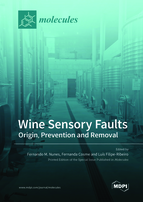Wine Sensory Faults: Origin, Prevention and Removal
A special issue of Molecules (ISSN 1420-3049). This special issue belongs to the section "Flavours and Fragrances".
Deadline for manuscript submissions: closed (31 December 2021) | Viewed by 30283
Special Issue Editors
Interests: food chemistry; wine quality and safety; Maillard reaction; melanoidins; nutraceuticals including gluten detoxification for celiac patients; phenolic compounds
Special Issues, Collections and Topics in MDPI journals
Interests: food science and technology; winemaking; alcoholic beverages; grapes; wine; wine stability; wine quality; wine aging; wine safety; fining; phenolic compounds; proteins
Special Issues, Collections and Topics in MDPI journals
Interests: food chemistry; oenology; analytical methods; winemaking; wine stability; phenolic compounds; aroma compounds; sensory analysis
Special Issues, Collections and Topics in MDPI journals
Special Issue Information
Dear Colleagues,
Wine is highly appreciated for its distinctive sensory characteristics, including its colour, aroma, and taste. However, unwanted microbiological activity, unbalanced concentrations of certain compounds resulting from unbalanced grape chemical compositions, and inadequate winemaking practices and storage conditions can result in the appearance of sensory defects that result in a significant decrease in wine quality. Wine stabilisation refers to removal and prevention strategies and treatments that limit visual, olfactory, gustatory, or tactile wine defects, as well as increase wine safety and stability through fining and the application of different operations carried out in wineries (filtration, pasteurisation, electrodialysis and cold stabilisation) and the use of emerging technologies (electron-beam irradiation, high hydrostatic pressure, pulsed electric fields, ultrasound, pulsed light). Although the prevention of wine defects is the best strategy, they are sometimes difficult to avoid; therefore, when present, several fining agents or additives and technologies are available or being developed with different performances regarding their impact on wine quality. Future trends in this field involve the use of more sustainable and environmentally friendly fining agents and technologies, and the development of treatments with better performance and specificity.
The aim of this Special Issue is to publish a compilation of original research and reviews that cover different aspects of wine sensory faults, their origin, prevention, and removal, and their impact on wine sensory quality.
Important aspects to be addressed are:
- Origins of the wine sensory faults;
- Impact of the wine faults on wine quality and safety;
- Prevention of wine faults either by viticultural or enological practices;
- The performance of available fining agents and new potential fining agents for the removal of wine defects, their selectivity, and impact on wine quality;
- Methods to estimate wine stability;
Original and review papers dealing with all aspects of wine sensory faults are welcome for inclusion in this Special Issue of Molecules.
Prof. Dr. Fernando M. Nunes
Prof. Dr. Fernanda Cosme
Prof. Dr. Luís Filipe-Ribeiro
Guest Editors
Manuscript Submission Information
Manuscripts should be submitted online at www.mdpi.com by registering and logging in to this website. Once you are registered, click here to go to the submission form. Manuscripts can be submitted until the deadline. All submissions that pass pre-check are peer-reviewed. Accepted papers will be published continuously in the journal (as soon as accepted) and will be listed together on the special issue website. Research articles, review articles as well as short communications are invited. For planned papers, a title and short abstract (about 100 words) can be sent to the Editorial Office for announcement on this website.
Submitted manuscripts should not have been published previously, nor be under consideration for publication elsewhere (except conference proceedings papers). All manuscripts are thoroughly refereed through a single-blind peer-review process. A guide for authors and other relevant information for submission of manuscripts is available on the Instructions for Authors page. Molecules is an international peer-reviewed open access semimonthly journal published by MDPI.
Please visit the Instructions for Authors page before submitting a manuscript. The Article Processing Charge (APC) for publication in this open access journal is 2700 CHF (Swiss Francs). Submitted papers should be well formatted and use good English. Authors may use MDPI's English editing service prior to publication or during author revisions.
Keywords
- wine sensory quality
- wine faults
- chemical and microbiological origin
- fining agents
- technological solution to improve wine stability
- wine stability
- wine stability tests









